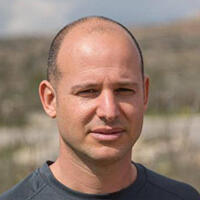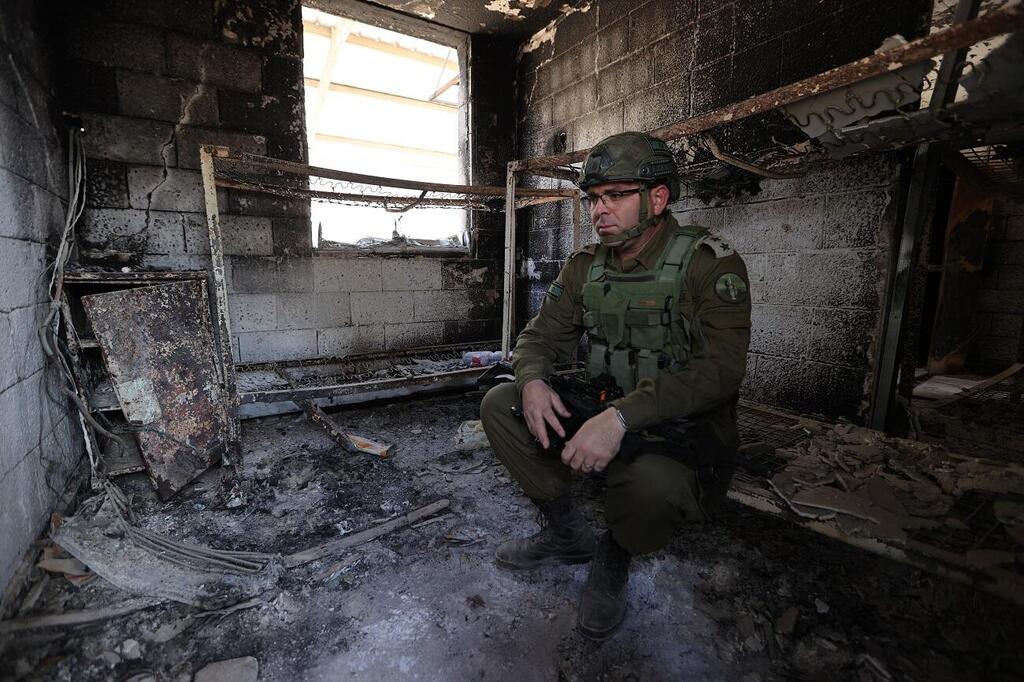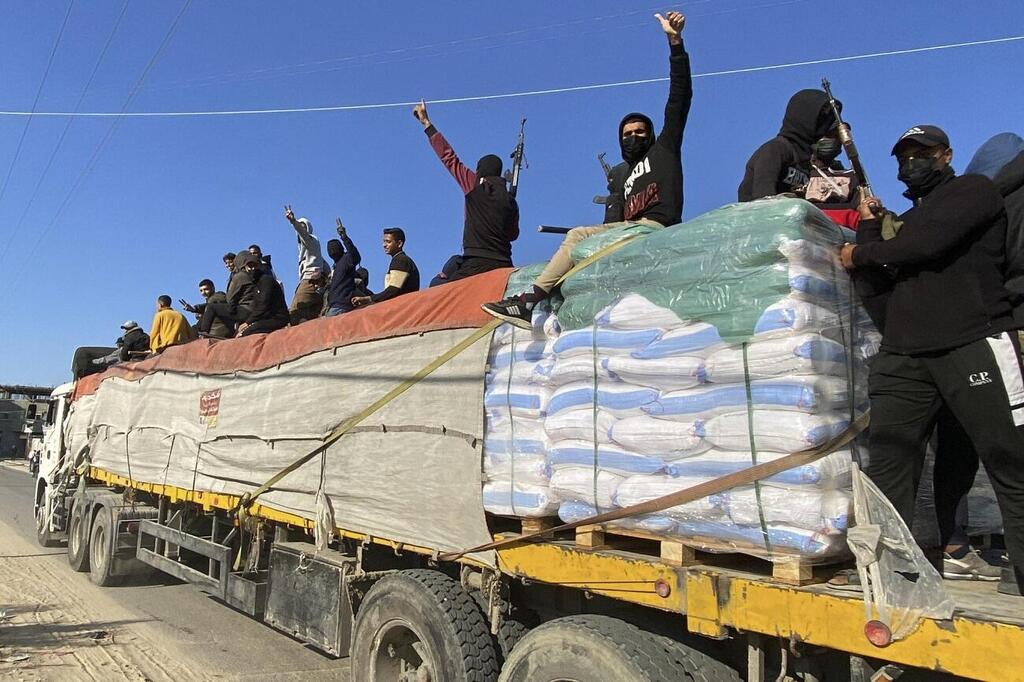It was a late night hour last November. Another installment of hostage release was supposed to be completed by now, but it hadn't even started. Meanwhile, the families of the hostages that are on the list to be released are anxious and terribly worried, looking forward to their release in anticipation, and an entire country is glued to the TV screens.
Read more:
"Technical delay", they say in Israel; "psychological terror employed by Hamas," the experts add. The tension is at its peak: is the release deal in danger?
5 View gallery
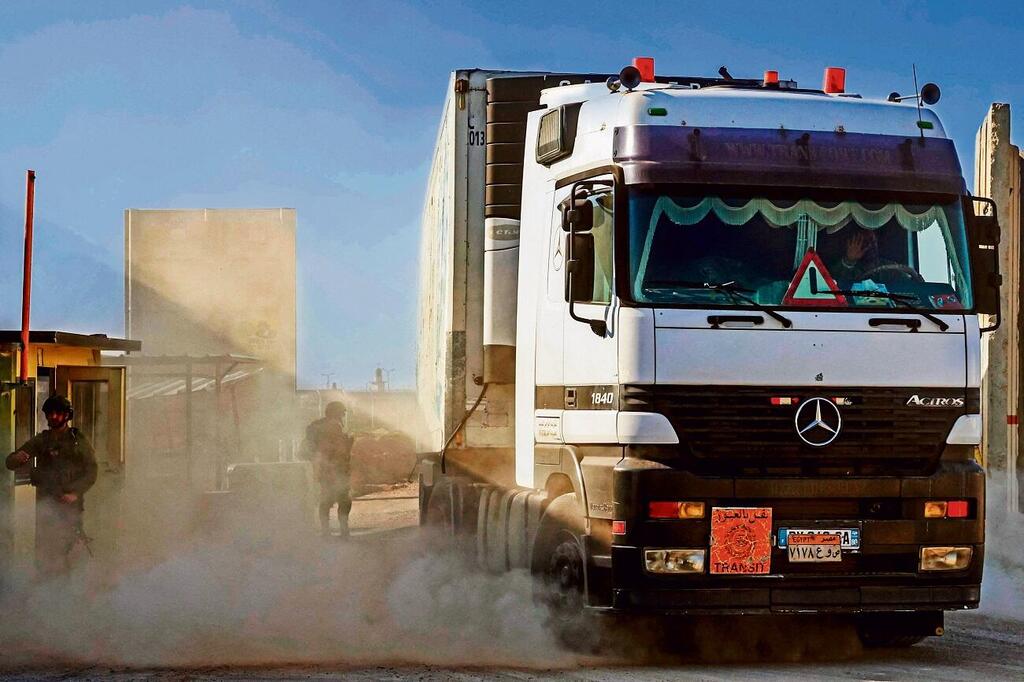

Humanitarian aid entering Gaza from Israel through the Kerem Shalom border crossing
(Photo: AFP)
Only a few people really know what is really happening in those critical moments. All the installments of the hostage deal, as we know, also involved the entry of humanitarian aid into the Gaza Strip.
This time the trucks did enter, but then the phone of Col. Moshe Tetro, 42, head of the Coordination and Liaison Administration (CLA) for Gaza - the military unit responsible for implementing civil policy concerning residents of the Gaza Strip - rang.
"It was my officer," Col. Tetro reveals for the first time the drama that unfolded there. "And he says: 'Tetro, you will never believe what just happened'. 'What happened?', I ask him. And he says: 'Right now, one of the trucks with humanitarian equipment slipped in a puddle and hit the truck in front of it on the Salah al-Din Road in the heart of Gaza. Both trucks are stuck. It's impossible to drive, what do you suggest we do?'
"I say to myself, Oh G-d, what a mess. This can screw up the whole phase. There are women and children here who are about to be released in just a moment, after being held captive by Hamas. You are in Gaza, at night, there's mud everywhere, there are lots of forces on the ground, and the hostages are waiting. It's impossible to explain what goes through your body in those moments."
So, what do you do?
"We are trying to figure out which of IDF vehicles are closest to the accident site, and if one of them can be used to rescue the trucks. We started improvising - we found an engineering vehicle that happened to be nearby, we connected it with a cable to the truck, and started to pull the truck out of the mud. We cleared the road to let the other trucks pass, cleaned the mud and pulled out the ones who got stuck. There was a delay, but the trucks reached their destination in the north of the Gaza Strip after all, and the hostages entered Israel. These are moments that are hard to explain."
5 View gallery
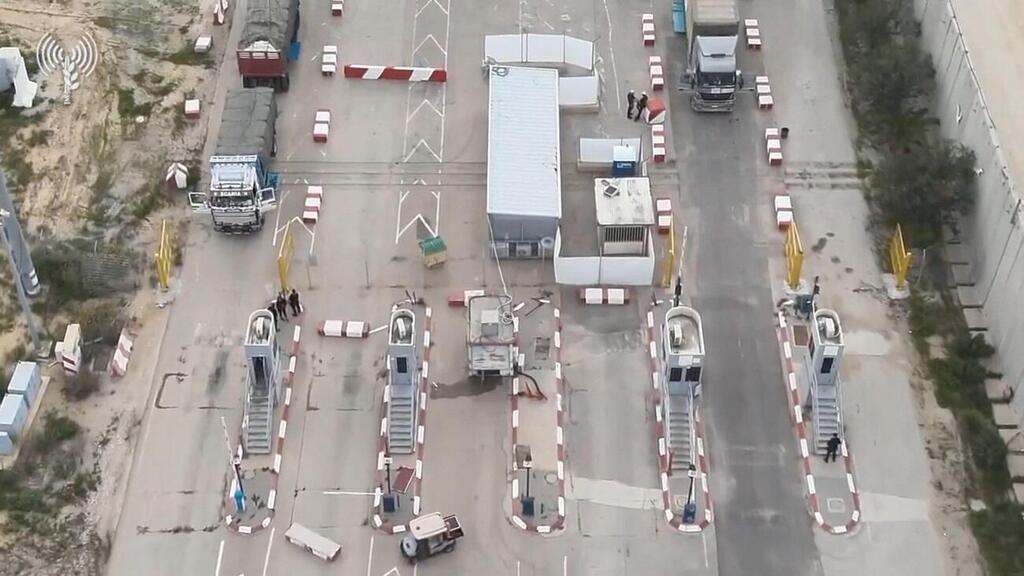

Humanitarian aid entering Gaza from Israel through the Kerem Shalom border crossing
(Photo: Reuters)
Try anyway.
"The return of hostages is an overwhelming event, emotionally, operationally, professionally; you name it. It involves several levels as far as I'm concerned. I met with the first two hostages right here (at Kerem Shalom crossing). And there is a huge excitement involved in returning citizens back home to Israel. It's a national mission. You have to make sure that everything goes properly, not to miss a thing or make any mistake that could cost in human life. It's a very complex coordination."
How is the coordination complex?
"I can't go into all the details, of course. But in general, let's say that this is a coordination that involves many factors and operations. You need to be aware of what is happening inside the Strip at the same time, what the process of handing over the hostages will look like, where the security Palestinian prisoners are released to.
"Of course, not everything is my responsibility, and there are many other units involved too. My humble role is to coordinate everything that is planned to happen. For example, some of these trucks had to reach the heart of Gaza City, where fighting IDF forces were situated, and we had to make sure the troops would not be shot at, G-d forbid.
"Or the prisoners, some were released to the West Bank, some to East Jerusalem and one of the prisoners was even returned to Gaza. It is complicated. In those minutes when the hostages are brought to the meeting point, the heart is pounding. There you fully understand that a failure, like a flat tire in some truck that doesn't arrive in time to the north of the Gaza Strip, can delay the release of four-year-old children. It's a huge sense of responsibility. On the one hand, we see the pictures that Hamas takes of the hostages in the Strip, we see Gazans knocking on the vehicles where the hostages are sitting, and your heart breaks; and you think about your little children."
And on the other hand?
"And on the other hand, when the hostages arrive in Israel you say: Wow, today I did something important."
'I was sure they were all dead'
That delayed release round which was eventually completed, as well as all the other rounds, until the deal layout collapsed. On all these occasions, Col. Tetro and his team were very much involved. The Coordination and Liaison Unit under his command is basically responsible for the entire civilian issue of Gaza: from entering humanitarian aid and its supervision, through the prevention of humanitarian diseases and disasters in the Strip, coordinating the entry and supervision of international aid organizations, transportation of wounded Palestinians and more.
He is responsible for the Kerem Shalom crossing, the Erez crossing, the Nitzana crossing and a control center called "HaMichlol", from which issues such as health, economy and international organizations in the Gaza Strip are being managed.
"[The Al Shifa Hospital director] was shocked by the situation at first, I don't think he believed that we would actually go in there. In some conversations I held with him he tried to object, saying, 'You can't do that, I have patients here,' etc., but I quickly moved on to explaining that according to the information we have, there is terrorist activity going on there.
All of this is normally very complex, but in times of war, it becomes even more difficult and more significant. Take, for example, the Neonatal Intensive Care Unit of the Al Shifa hospital: the IDF wants to enter the hospital grounds and eliminate terrorists and dismantle the infrastructure there. The last thing the IDF and the entire State of Israel need are pictures of dead premature babies being hit by gunfire or because the electricity for their incubators was cut off. It's not right both morally and tactically. Now you have to contact, amid the war and under fire, the Al Shifa doctors, and then organize a safe place for premature babies, including ambulances to take them there.
"I personally spoke with the director of the Al Shifa hospital," says Col. Tetro, "and I explained to him that he must evacuate all the people from the hospital because the IDF intends to go there. Meanwhile, there are dozens of coordination talks between the various departments. Such as evacuating patients or premature babies. At the same time, we set up a hospital for them in the south of Gaza to which they can move."
How did the Al Shifa director respond to your call?
"He was shocked by the situation at first, I don't think he believed that we would actually go in there. In some conversations I held with him he tried to object, saying, 'You can't do that, I have patients here,' etc., but I quickly moved on to explaining that according to the information we have, there is terrorist activity going on there.
"Eventually, we took the wounded and sick people who were in intensive care out of Al Shifa and transferred them to other hospitals, most of them located inside the Gaza Strip. We even transferred some of the premature babies to Egypt. In total, we transferred over 100 injured people to suitable places in ambulances of the Palestine Red Crescent Society and with the help of international organizations. The evacuation and transferring of a population are something we do on a daily basis, even now."
5 View gallery
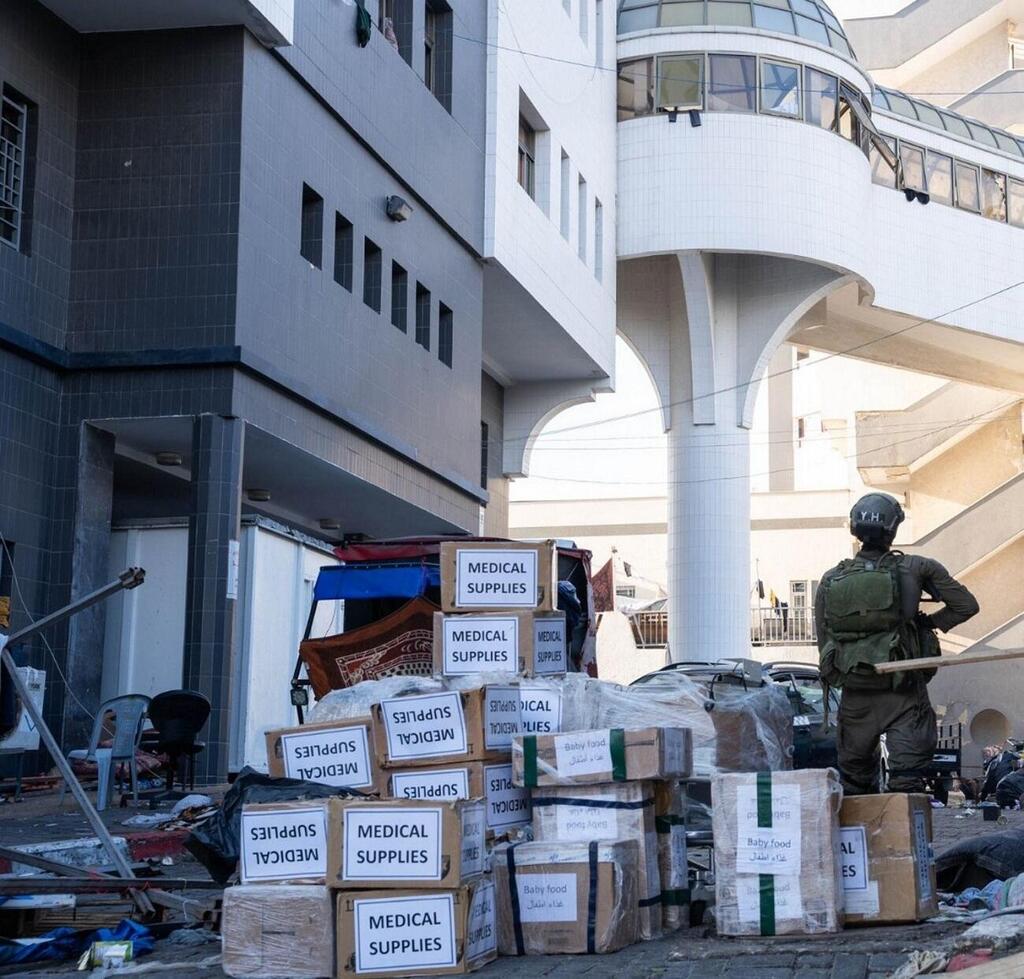

Medical supplies provided by the IDF to Gaza City's Al Shifa Hospital
(Photo: IDF Spokesperson's Unit)
Why? What happened now?
"Yesterday, a family that remained in the north of the Gaza Strip, in the Darj Tuffah neighborhood, contacted us saying that the 162nd Division is fighting around them and they wish to relocate to the south. They see tanks in their backyard. Our teams locate them, talk to the forces of the division and coordinate evacuation routes. This operation was planned last night and was carried out just a few minutes ago."
Col. Tetro joined the CLA shortly after 2021's Operation Guardian of the Walls, a period when many IDF and Israeli government officials were convinced that Hamas was now prioritizing the welfare of the residents of the Gaza Strip, thinking that the more the economy, health and infrastructure of Gaza improved, the less the terrorist organization's motivation was to attack. The IDF called it "the price of losing", i.e. creating a situation in which Israel improves the conditions of Gazans so that Hamas refrains from military operations. Today, by the way, it is simply called " the conception".
"The idea was to produce a civilian policy that corresponds with the population, and not with Hamas," Tetro explains. "Throughout the duration of this policy, I never thought that Hamas would change its skin, and we had no aspiration that it would turn into a pursuer of peace."
This 'price of losing' concept didn't really work.
"It is clear that Hamas remains Hamas and it was also clear to me that whenever it had the opportunity it would attack. But I never imagined that the attack would be of this magnitude. By the way, I also refer to the Gazan population. We were trying to create dynamics that would allow separating terrorism from the population. Hamas is using the population as a tool; this is the center of its strategy. Every civil event involves Hamas. Therefore, it is very complex.
"My soldiers who were killed here, their job was to allow the entry of food into the Gaza Strip and to deal with medical issues. And that's what they attacked."
"Our CLA base constitutes the hand that feeds the residents of the Gaza Strip. The attack of the base they knew, is in fact biting the hand that feeds them, allowing them to make a living and live. My soldiers who were killed here, their job was to allow the entry of food into the Gaza Strip and to deal with medical issues. And that's what they attacked."
So, do you feel any remorse? Are you saying that it is impossible to separate terrorism from the population in the Gaza Strip?
"Look, in the end, we implemented the government's policy. We thought we could do it. But Hamas is an idea of resistance and an idea that cannot be destroyed and cannot be removed from a person's head. And in this sense, the statement of separating terrorism from the population is too simplistic. I don't think the entire population in Gaza are Hamas operatives, I don't know how many of them are, but our task right now is to eliminate and destroy Hamas' military capabilities. That can be done.
"As for the population, you should understand: we live in a complex world, and this war is very difficult and is made up of many tensions; one of them is the international legitimacy to act. We should make a civil effort while fighting. This effort is not 'nice to have' but 'must have'. And of course, we should consider the scope of this civil effort. Humanitarian aid can be given in one way or in another way. Here we are talking about the minimum humanitarian threshold required, which is food, water, medicine an' drived equipment for shelters."
Quite a few commentators claim that humanitarian aid should be stopped, to impose greater pressure on them, similar to what Golda Meir did on Yom Kippur with the Egyptian Third Army.
"I am not Golda Meir. There is a state, and there is a government, and we implement the decisions made by the Cabinet. I do not set the laws of war, but we must comply with the international laws of war. The IDF is not a war criminal, and I, on a personal and deepest level, am proud of that.
"We are fighting a terrorist organization whose core strategy is to fight from within the population, and the IDF is using unprecedented firepower in maneuvers in the Gaza Strip. To allow this, civilian conditions must be maintained. So, we moved the citizens to the south, so that the IDF does not fight children and grandmothers, and this actually makes it possible to fight and does not impair the fighting.
"We allowed the entry of tents to be set up in Al-Mawasi, and this allowed us to evacuate the population from Khan Younis in order to fight there. We relocated a million and a half people, and if you don't provide them with a civil response it could backfire on you in a second. I estimate that the war will stop quite quickly if famine, epidemics and an acute humanitarian crisis develop in the Strip."
Col. Tetro is the father of three daughters and lives in Ashkelon. On the morning of October 7, he got a phone call informing him that terrorists had infiltrated the base. The Gaza CLA is located right next to the Erez crossing, a few minutes' drive from Moshav Netiv Ha'Asara. The base was attacked in two places by dozens of terrorists from Hamas' elite Nukhba force. Tetro ran from his house toward the base, but was stopped at the Yad Mordechai intersection.
"We encountered dozens of terrorists there, and together with IDF forces and the police we opened fire on them," he recalls. "Very quickly I realized that I would not be able to reach the base."
The CLA military base comprises many soldiers who are not trained for combat. In case of infiltration of terrorists into the base, an infantry force, which is permanently stationed there, is supposed to provide military defense. Golani fighters were there that morning. The terrorists blew up the entrance gate and swarmed in while firing heavily. At that time Tetro's soldiers woke up from the sirens and ran to the shelters, some of them partly dressed.
"The terrorists were familiar with the base, they knew exactly where to go," says Tetro. "They entered my office and destroyed it to the ground."
The base was completely occupied, and the terrorists walked through it with ease. Most of the soldiers at the base fled to the shelter. At this point, Tetro had already lost contact with his soldiers. "I was sure they were all dead," he says. At one point, he saw among the Hamas videos two of his soldiers, Ron Sherman and Nick Beiser, being taken captive by Hamas while they were still alive.
About ten hours later, when the base was under the control of Hamas terrorists, IDF paratroopers and special combat engineering units arrived and recaptured it. The results are harsh. Three CLA soldiers were killed in the attack, and three more were abducted to the Gaza Strip. The IDF recovered the bodies of Nick Beiser and Ron Sherman in mid-December following a complex operation in the heart of the Gaza Strip.
And after all this, you go back to bringing food, medicine, and other products into the Gaza Strip.
Tetro: "It's quite complicated. It's a task that seems to be non-military in essence, as an opposite vector of combat. It also involves a very personal level: the late Ron Sherman routinely took care of getting trucks into Gaza, for the benefit of people there, and he was kidnapped and murdered in Gaza, and now his peers in the unit have to do it. And Jonathan, who started the war in a safe room, now coordinates things for the benefit of people in Gaza.
"And as for myself, some of my soldiers were either killed or kidnapped, and I live in Ashkelon and my daughters have to hide in the safe room, and yet I am responsible for this humanitarian aid. But in general, it is very clear to me why I am making this civilian humanitarian effort. It is important to understand that without this humanitarian aid, it would be impossible to get American political support when using firepower of such magnitude. I am a soldier in the IDF who fights against an enemy and wins while striking at lethal level - but I must comply with the international humanitarian law."
An overview
We leave the Gaza CLA military base at the Erez crossing and travel to the Sde Teyman (Teyman Airfield) base. Here, among the multitude of unit bases, Tetro's base is also hidden, the "Gaza Coordination and Liaison Headquarters", or as it is colloquially known "HaMichlol".
It comprises some operations rooms, each one dealing with a different topic. In the information and evaluation center, for example, people work to get up-to-date information on the civil government in Gaza. The screens play the Al Jazeera network. Others broadcast information from the Gaza Municipality, and show social media pages of key officials in the city. The soldiers serving in this operation room also maintain personal and daily connection with business owners, heads of organizations and lawyers, in order to have a closer look at what is happening on the ground.
I see here on the screens WhatsApp and Telegram groups.
"We are tracking the main figures there," explains Sergeant Major H., a researcher at HaMichlol. "We are trying to figure out all kinds of issues from them, such as mindset or governance."
This is how you can understand if Hamas has lost its grip and where?
"Sure. We, for example, check what's happening in the local authorities. For us, they are considered a layer of governance. Their government ministries, public order and Hamas's security mechanisms – we learn how much they are involved on the ground and if they are still in power, while above all this we are trying to figure out their public legitimacy, that is whether the Hamas government has not lost its public grip yet. In addition, we integrate the messages that emerge from the talks we hold with the Gazans. We process all this information, trying to see what the situation of the Hamas' governance is."
"Hamas releases a picture of the organization's officials walking around the streets, as if to show governance. It is clear to us that this is for show. It is all propaganda, which means, 'see? I exist and operate on the ground'."
So, what is happening in Gaza now as we speak? What can you tell about Hamas' governance situation now?
"In the north, that is, Jabaliya and Gaza City, there's a catastrophe. There is almost no governance there. This means in practice that there are neighborhoods where waste is not disposed of, and municipal services are not being provided; the Gaza Municipality announced that all its departments stopped functioning. Such things harm Hamas' civilian control. And the fact is, Hamas releases a picture of the organization's officials walking around the streets, as if to show governance. It is clear to us that this is for show. It is all propaganda, which means, 'see? I exist and operate on the ground'."
How do you know it's a show?
"There is no evidence of governance in northern Gaza. Residents who are still in the north break into strangers' homes and take food from there. No services are being provided, and therefore there is no governance. It is very different from what is happening in the south. There you constantly see Hamas operatives moving around in jeeps and siren lights in a demonstrative manner, including firing into the air, securing the aid convoys. This is an expression of governance. We also see looting there, but Hamas controls the south. Looters do not come from ordinary families but are from rather well-known and very powerful crime families."
And after all this, what do you hear from the population?
"The truth at this stage must be told: there is still public recoil from Hamas. To our understanding, the Gazan residents still do not believe that Hamas is leaving in the near future, and that is why they are afraid of the day after."
We went outside and entered the Civic Center operation room, which contains a number of "units", each of them deals with a different topic: international organizations, infrastructure coordination, economy and health, which adds up to an entire civilian operation. Here, too, it is a small trailer with a small number of people, who are in contact with the entire world.
"Our role here is to compose an up-to-date picture of the health situation in the Gaza Strip," explains Capt. Dvir Lifshitz, commander of the health unit. "In general, there are 35 hospitals in the north of the Gaza Strip, including various clinics, and another 24 in the south. Currently, less than four are operating in the north and about ten in the south. But this can change at a moment's notice and depends on the military effort, because once we incriminate a hospital, it is impossible to operate it, and when we are done, the situation changes."
So what do you do?
"We have an up-to-date picture of which hospitals are active and which are not, how many patients there are, what treatments they need, and what each hospital can provide. For example, treatment for cancer patients, which the Turkish Hospital specializes in, or dialysis treatments that are provided at Beit Hanoun Hospital. Then we transport patients to the appropriate hospitals to receive the proper medical care.
"Since some hospitals have turned into terrorist headquarters, we are relocating medical capabilities from the north to the south. In order to move from Al Shifa Hospital to the European Hospital in ambulances, amid war, when divisions are maneuvering, you need to coordinate."
At the international organizations unit, we met Sergeant Yonatan Shimonovitz, 21, originally from Germany, who has been communicating in several languages with the various organizations for two months now. Shimonovitz is a resident of Moshav Netiv Ha'Asara and a survivor of the October 7 massacre.
"I was in the moshav that morning, and together with my father we locked ourselves in the safe room for almost 12 hours," he recalls. "We were approached by the terrorists who came with drones. They literally landed next to our house. All this time we made sure to keep the door of the safe room closed, so that no one would enter. Our luck was that the terrorists skipped us. At a certain point, around 5:30pm, we managed to get into our car and we simply fled from there and thus saved our lives."
And now you are here.
"Yes. I speak English with the various organizations, I also speak German at a mother tongue level, and I manage to understand and communicate in French and Italian," he explains. "When you talk to Europeans you have to be very nice, you have to understand how they convey their messages, what expressions they use, and what they mean. This is not obvious to many people. I must say that Europeans and Americans alike think we are brutish, vulgar people. But we must convey our message no matter what, and the message should be clear on the other side. And more essentially, it is important that we understand the message they're trying to convey to us."
Poignant questions
We leave HaMichlol in Teyman Airfield and drive to the Kerem Shalom crossing. Here, the same well-known inspection is carried out for trucks entering from Egypt, before they reach the Gaza Strip, where - at least in some cases - they are looted by Hamas operatives.
The commander in charge here is Lieutenant Liel Yitzhakov, 22, who explains to us that the trucks arriving from Egypt undergo a sterile inspection here, and another one at the Nitzana crossing, and she and her people make sure that all the cargo inside the trucks is indeed approved for entry into Gaza.
"There were some unusual items that should not have come here," she says. "It's not about smuggling attempts or anything, just coordination problems, apparently. At the Nitzana crossing, for example, we saw drones that arrived as a donation. We spotted them, and immediately took them out. In another case, a truck with condoms arrived here a few days ago. We identified it as unusual and did not let it enter. It should be noted that apart from what the UN transfers, there are also a lot of donations from around the world to Gaza. We go over it and determine what is allowed to enter and what cannot."
At the Nitzana crossing, troops check about 120 trucks a day. At the Kerem Shalom crossing, about another 80. The soldiers, most of them young, remember very well what happened at their base, and in general on October 7, and despite that, they are now approving the entry of food and medicine into Gaza.
"There are a lot of questions we are asked and a lot of dilemmas involved in my work," admits Lt. Yitzhakov. "A lot of the forces that work here and cross the border often ask me, 'How can you do this every day?'"
And really, how?
"Obviously it's not the most ideal thing to do. But at the end, you look at a truck and you see the ongoing fighting or the ability to reach another hostage and bring them home. I was not happy and enthusiastic about this mission, but you are part of something that is much bigger than you. I will live to tell my children what I did in this war."
Commander Tetro himself also faces this dissonance. Until October 6, his unit allowed the passage of goods from Israel to Gaza, and of seriously ill patients for treatment from Gaza to Israel. On October 7, the people who may have eaten from those trucks and whose relatives were saved in the hospitals in Israel - went out to slaughter Israelis.
"I'm still not sure about the significance of all this," he says honestly. "A huge thing happened here that is much bigger than my perception of Gaza. We are required to ask poignant and deep questions at all levels. Personally, vis-a-vis the soldiers, I feel that I failed because I was not able to save their lives. It makes me question what I could have done differently".
Does it make you wonder about what you've been doing here for the last few years?
"What I did here was create a policy that served a security concept. I was not asking to feed Hamas, that's the last thing I wanted, but it is impossible to ignore the fact that in the end, the residents of the Gaza Strip made a living working in Israel and saved their lives in hospitals in Israel; businessmen in the Strip made their fortunes from exports to Israel, by passing this crossing (Kerem Shalom), and eventually Hamas came and cut off that hand. I think that if there is someone who can significantly shorten the war - I don't know if it will happen, and I'm not too optimistic about it either - these are only the people of Gaza. They need to understand that someone will destroy Hamas, and it's either us - or them. I think they can do it faster."
And what if they don't?
"If they don't, then it's us. And we're on our way."



